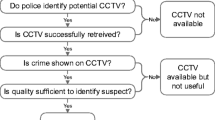Abstract
We tested the accuracy of thermal imaging as a lie detection tool in airport screening. Fifty-one passengers in an international airport departure hall told the truth or lied about their forthcoming trip in an interview. Their skin temperature was recorded via a thermal imaging camera. Liars’ skin temperature rose significantly during the interview, whereas truth tellers’ skin temperature remained constant. On the basis of these different patterns, 64% of truth tellers and 69% of liars were classified correctly. The interviewers made veracity judgements independently from the thermal recordings. The interviewers outperformed the thermal recordings and classified 72% of truth tellers and 77% of liars correctly. Accuracy rates based on the combination of thermal imaging scores and interviewers’ judgements were the same as accuracy rates based on interviewers’ judgements alone. Implications of the findings for the suitability of thermal imaging as a lie detection tool in airports are discussed.

Similar content being viewed by others
Notes
Passengers who did not take part gave good reasons to do so: They were busy (had work or shopping to do), travelled with more people or had to catch their flight. The reasonably high response rate may have been a combination of an official looking experimenter combined with the opportunity to earn money and serving a good cause (scientific research that could be used to enhance security at airports).
These questions were asked to establish the ground truth in the experiment. All participants (truth tellers and liars) were asked to reveal their true destination during the actual interview, and truth tellers were also asked to reveal the true purpose of their trip. When we compared the answers during the actual interview with the answers given to the experimenter, we noticed that all interviewees honestly reported their destination, and that all truth tellers honestly reported the true purpose of their trip.
A logistic regression analysis revealed similar results. That is, the results for baseline and Phase 1 were not significant, but the results for Phases 2 and 3 were significant. When we entered Phase 3 and the interviewers’ veracity judgement in the regression analysis, the interviewers’ judgement variable emerged as the only predictor.
References
Bond, C. F., & De Paulo, B. M. (2006). Accuracy of deception judgements. Personality and Social Psychology Review, 10, 214–234. doi:10.1207/s15327957pspr1003_2.
Cohen, J. (1988). Statistical power analysis for the behavioral sciences (2nd ed.). Hillsdale, NJ: Erlbaum.
DePaulo, B. M., Lindsay, J. J., Malone, B. E., Muhlenbruck, L. M., Charlton, K. C., & Cooper, H. (2003). Cues to deception. Psychological Bulletin, 129(1), 74–118.
Granhag, P. A., & Knieps, M. (in press). Episodic future thought: Illuminating the trademarks of true and false intent. Applied Cognitive Psychology.
Köhnken, G. (2002). A German perspective on children’s testimony. In H. L. Westcott, G. M. Davies, & R. H. C. Bull (Eds.), Children’s testimony: A handbook of psychological research and forensic practice (pp. 233–244). Chichester: Wiley.
Köhnken, G. (2004). Statement Validity Analysis and the ‘detection of the truth’. In P. A. Granhag & L. A. Strömwall (Eds.), Deception detection in forensic contexts (pp. 41–63). Cambridge: Cambridge University Press.
McIntosh, D. N., Zajonc, R. B., Vig, P. S., & Emerick, S. W. (1997). Facial movement, breathing, temperature, and affect: Implications of the vascular theory of emotional efference. Cognition and Emotion, 11, 171–195. doi:10.1080/026999397379980.
Merla, A., & Romani, G. L. (2007). Thermal signatures of emotional arousal: A functional infrared imaging study. In Proceedings of the 29th annual international conference of the IEEEE EMBS (pp. 247–249).
National Research Council. (2003). The polygraph and lie detection. Committee to review the scientific evidence on the polygraph. Washington, DC: The National Academic Press.
Pavlidis, J., Eberhardt, N. L., & Levine, J. A. (2002). Seeing through the face of deception. Nature, 415, 35. doi:10.1038/415035a.
Pavlidis, I., Levine, J., & Baukol, P. (2001). Thermal image analysis for anxiety detection. Proceedings of the International Conference on Image Processing, 2, 315–318.
Rice, M., & Harris, G. T. (2005). Comparing effect sizes in follow-up studies: ROC area, Cohen’s d, and r. Law & Human Behavior, 29(5), 615–620. doi:10.1007/s10979-005-6832-7.
Vrij, A. (2008). Detecting lies and deceit: Pitfalls and opportunities (2nd ed.). Chichester: Wiley.
Vrij, A., Granhag, P. A., Mann, S., & Leal, S. (in press). Lying about flying: The first experiment to detect false intent. Psychology, Crime, & Law.
Vrij, A., Leal, S., Granhag, P. A., Mann, S., Fisher, R. P., Hillman, J., & Sperry, K. (2009). Outsmarting the liars: The benefit of asking unanticipated questions. Law and Human Behavior, 33, 159–166. doi:10.1007/s10979-008-9143-y.
Vrij, A., Leal, S., Mann, S., & Granhag, P. A. (in press). A comparison between lying about intentions and past activities: Verbal cues and detection accuracy. Applied Cognitive Psychology.
Vrij, A., Mann, S., Fisher, R., Leal, S., Milne, B., & Bull, R. (2008). Increasing cognitive load to facilitate lie detection: The benefit of recalling an event in reverse order. Law and Human Behavior, 32, 253–265. doi:10.1007/s10979-007-9103-y.
Author information
Authors and Affiliations
Corresponding author
About this article
Cite this article
Warmelink, L., Vrij, A., Mann, S. et al. Thermal Imaging as a Lie Detection Tool at Airports. Law Hum Behav 35, 40–48 (2011). https://doi.org/10.1007/s10979-010-9251-3
Published:
Issue Date:
DOI: https://doi.org/10.1007/s10979-010-9251-3



